A Surrogate Modeling Approach for Aggregated Flexibility Envelopes in Transmission–Distribution Coordination: A Case Study on Resilience
Abstract
1. Introduction
1.1. Flexibility Capabilities and Optimization Challenges
1.2. Novelty and Contributions of This Work
- The DSO constructs the surrogate model, reserving part of the flexibility for local needs (e.g., voltage regulation, congestion management).
- The equivalent surrogate model of residual flexibility is communicated to the TSO.
- The TSO optimizes system operation based on the surrogate devices and transmits set-points to the DSO.
- The DSO disaggregates these set-points and applies them to individual distributed resources (more specifically to the balancing/flexibility service providers).
1.3. Structure of the Manuscript
2. Surrogate Model of Distribution Network
- The rated power of the wind generator at bus 7 is increased from 1.5 MW to 9 MW.
- The lines connecting bus 3 to bus 8, and bus 7 to bus 8 are reinforced.
- The existing storage units at bus 5 and bus 10 are exploited to mitigate local congestion caused by excess generation. These units have maximum active powers of 0.6 MW and 0.2 MW, capacities of 1.2 MWh and 0.4 MWh, respectively, and a round-trip efficiency of 81%.
- An additional storage unit with a capacity of 2 MWh and a maximum power of 1 MW is connected to bus 14, featuring a round-trip efficiency of 81% too.
- a lumped storage unit,
- a lumped generator,
- and a lumped load.
- Solve the optimal local dispatch problem for the distribution network. This step identifies the optimal set-points for all flexible resources, aiming to resolve local congestion while minimizing the overall cost, including both local generation and power inflow from the transmission system.
- Classify all components based on their techno-economic characteristics. This includes their capability curves (e.g., rectangular or triangular), internal constraints, and flexibility costs. Each category of components is then represented by a single lumped element in the surrogate model.
- Establish a merit order within each category, ranking components by their flexibility cost. Following this order, the aggregate capability of each category is computed in terms of the active and reactive power that can be delivered to the transmission system via the primary substation.
- Derive the parameters of each lumped element from the analysis of the aggregated capability curves. These parameters define the behavior of the surrogate model and ensure it accurately reflects the underlying network.
2.1. Distribution Network Baseline
2.2. Model of the Surrogate Storage Unit
- Fix the dispatch of all flexible resources except storage: All non-storage flexible units are constrained to follow the power set-points determined by the optimal local dispatch (as described in Section 2.1). This ensures that their contribution to local congestion management is preserved and does not interfere with the analysis of storage flexibility.
- Relax the intertemporal constraints of the storage model: While the structural model of the storage units is maintained, the energy balance constraints (which link power injection and absorption over time) are temporarily disabled. This allows the analysis to focus solely on the instantaneous power capability of the storage system, without being influenced by its current state of charge.
- Numerically reconstruct the equivalent capability: Using one of the approaches described in literature (e.g., the one proposed in [24]), the aggregated capability of the lumped storage unit is computed at the point of common coupling between the transmission and distribution networks. This reconstruction returns a capability curve (as shown in Figure 6a), which reflects the maximum active and reactive power that the storage system can exchange at a given moment.
2.3. Model of the Surrogate Generation Unit
- The intertemporal constraints of the storage units are removed, and their maximum injection/absorption limits are adjusted to match the capability determined in the previous step. This ensures that the influence of storage active and reactive power on the network is properly considered.
- The flexibility of all generators is enabled, allowing them to modulate their output power. Meanwhile, the load profiles are fixed to the values obtained from the optimal local dispatch, meaning that load curtailment is disabled during this phase.
- The equivalent capability of the generators is then numerically reconstructed at the point of common coupling between the transmission and distribution networks. This reconstruction is carried out using the methodology described in [24], and an exemplificative capability curve is illustrated in Figure 9a.
2.4. Model of the Surrogate Load Unit
- The intertemporal constraints of storage units are removed, and their maximum injection/absorption limits are adjusted to match the capability obtained in the previous step.
- The flexibility of all generators and load units is enabled, allowing for the simulation of demand curtailment.
- The equivalent capability is then numerically reconstructed at the point of common coupling between the transmission and distribution networks, following the methodology described in [24].
- The rectangular capability of the combined lumped storage and generator is plotted in its original position, centered around the baseline operating point .
- This rectangle (curve E) is then translated along with the load reduction trajectory, simulating increasing demand curtailment.
- The translation continues until one edge of the rectangle touches the numerically calculated capability boundary (curve B). At this point, the active power shift is measured (Figure 11b), which defines the reference power of the surrogate load.
3. Analysis of the Obtained Surrogate Model
- The best correspondence occurs during the morning hours (5:00 ÷ 12:00), when load demand is high and helps counterbalance local generation, reducing congestion. In these conditions, the surrogate model achieves a maximum matching of 84%.
- The worst correspondence is observed during the evening and early morning (18:00 ÷ 5:00), when demand is low and high generation leads to network saturation. In these cases, flexibility margins are reduced, and the surrogate model matches the complete one by only about 60%.
4. Application of the Surrogate Models for Distribution Flexibility Integration in Transmission Resilience Enhancement Framework
- Limiting the exchange of active/reactive power in the primary substation.
- Increasing the counter-flow of energy to supply a portion of the load belonging to neighboring distribution networks.
- Participating in voltage regulation by modulating the reactive power exchanged between the transmission and distribution systems.
- The DSO collects information on the operating status of the individual resources and estimates their potential in terms of varying the power flow in the primary substation (while considering the constraints of the distribution network).
- The DSO communicates the overall flexibility potential to the TSO, in terms of possible changes in active and reactive power.
- The TSO evaluates the conditions of its own network and, based on the actual flexibility available, communicates the optimal set-point to the DSO.
- The DSO receives the information, disaggregates it, and communicates the optimal set-points to the flexible resources involved.
4.1. Coordinated Framework for Resilience Enhancement
- Preventive actions consisting of:
- ○
- Modification of the set-point of the generation component of the surrogate model within the capability.
- Corrective actions consisting of the following actions on the surrogate model:
- ○
- Modification of the power set-point of the generation component.
- ○
- Reduction in the power absorbed by the load component.
- ○
- Absorption and/or injection of power by the storage.
4.2. Application Results
- (1)
- The threat evolution (whereby components are struck by threat at specific hours of interest, thus, the most probable contingencies affecting the system can be identified).
- (2)
- The operating point of the power system: in quasi-real-time operation the uncertainties concerning forecast errors on load demand and renewable generation can be considered negligible.
- (3)
- The distribution network behavior in case of severe contingencies affecting the transmission system.
- (4)
- The localization and configurations of distribution networks.
- (5)
- The cost profile for the ancillary services from distributed resources to support transmission system resilience.
- Operation 1: distribution resources provide ancillary services for resilience support to the transmission system
- Operation 2: distribution resources intervene in case of emergencies by shedding at high costs a fraction of the total load and/or generation components.
- Operation 3: distribution resources do not intervene in case of contingencies: in case of nodal power imbalance at their point of common coupling due to the loss of connectivity to the transmission system, they open the breaker of primary substation and start working with zero power exchange (islanded mode).
- Profile A: medium costs for upward and downward variations of the distribution network power exchanges.
- Profile B: high costs for upward and downward variations of the distribution network power exchanges.
- Profile C: low costs for upward and downward variations of the distribution network power exchanges.
4.2.1. Provision of Ancillary Services at Moderate Costs (A1)
4.2.2. Load and Generation Shedding Automatisms (A2)
4.2.3. No Support from Distribution Resources, and Moderate Costs for Load Generation Shedding (A3)
4.2.4. Provision of Ancillary Services at High Costs (B1)
4.2.5. Provision of Ancillary Services at Low Costs (C1)
4.3. Discussion of Surrogate Model Application and Disaggregation of Set-Points
- (1)
- Surrogate models are very effective and easy to use for the integration of distribution network flexibility curves (and the relevant ancillary services) inside frameworks for TSO-DSO coordinated actions to support system resilience.
- (2)
- The contribution from the ancillary services from distribution resources for resilience support allows to achieve lower costs for control actions (as highlighted by the comparison between case A1 and cases A2, A3), possibly also attaining lower CVAR values (see cases A1 vs. A3).
- (3)
- Simpler forms of interactions between distribution network and transmission system, such as emergency shedding schemes for load and generation (operation mode 2 in Section 4.2), can be useful to achieve the same minimum CVAR value as in case of ancillary services provision, but at higher expected costs for corrective actions (see cases A1 and A2).
4.3.1. Variation in the Active Power Exchange at the TSO-DSO Interface
4.3.2. Active Power Set-Points for Individual Storage Units
4.3.3. Active Power Set-Points for Individual Generation Units
4.3.4. Application of Reactive Power Set-Points
- Case α: The reactive power variation is fully satisfied by the storage units.
- Case β: The reactive power variation requires additional support from generation units to meet the TSO request.
- Case γ: Although the reactive power variation could theoretically be satisfied using only storage and generation units, the approximation introduced by the surrogate model leads to load curtailment to fulfill the request (resulting in a suboptimal disaggregation of set-points).
- Storage units participate in all cases, being the first elements in the merit-order list. In particular, case α is characterized by the activation of the storage unit connected to bus 14 only, as its contribution is sufficient to meet the reactive power request.
- Generation units are involved in cases β and γ, supporting the storage units. In case γ, their contribution is limited by grid constraints (see Figure 30a).
- Loads are required to reduce their active power consumption by more than 1 MW to adjust the total reactive power and provide the remaining 0.26 MVAr that cannot be delivered by other resources.
5. Conclusions
Author Contributions
Funding
Data Availability Statement
Conflicts of Interest
References
- Pilo, F.; Mauri, G.; Bak-Jensen, B.; Kampf, E.; Taylor, J.; Silvestro, F. Control and automation functions at the TSO and DSO interface—Impact on network planning. In Proceedings of the International Conference on Electricity Distribution, Galsgow, UK, 12–15 June 2017. [Google Scholar]
- Pilo, F.; Mauri, G.; Hanlon, S.; Jupe, S.; Silvestro, F. Control and automation systems for electricity distribution networks of the future—An update on the activities of joint working group CIGRE C6.25/B5/CIRED. In Proceedings of the International Conference on Electricity Distribution, Lyon, France, 15–18 June 2015. [Google Scholar]
- Kornrumpf, T.; Zdrallek, M.; Roch, M.; Salomon, D.; Pyro, P.; Hobus, I. Flexibility Options for Medium Voltage Grid Planning. In Proceedings of the International Conference on Electricity Distribution, Galsgow, UK, 12–15 June 2017. [Google Scholar]
- Nguyen, H.; Kok, K.; Tran, T.T.; Nguyen, P.H. The Coordination Between TSO and DSO in the Context of Energy Transition—A Review. In Proceedings of the International Universities Power Engineering Conference, Cardiff, UK, 2–6 September 2024. [Google Scholar]
- Couto, M.; Javadi, M.S.; Osório, G.J.; Catalão, J.P.S. Global Perspectives on Tso-Dso Coordination Models for Distributed Energy Resources Market Integration. In Proceedings of the International Conference on the European Energy Market, Lisbon, France, 27–29 May 2025. [Google Scholar]
- Viganò, G.; Lattanzio, G.; Rossi, M. Review of Main Projects, Characteristics and Challenges in Flexibility Markets for Services Addressed to Electricity Distribution Network. Energies 2024, 17, 2781. [Google Scholar] [CrossRef]
- Silvestro, F.; Pilo, F.; Araneda, J.C.; Braun, M.; Taylor, J.; Alvarez-Herault, M.C.; Heymann, F. Review of Transmission and Distribution Investment Decision Making Processes under increasing Energy Scenario Uncertainty. In Proceedings of the International Conference on Electricity Distribution, Madrid, Spain, 3–6 June 2019. [Google Scholar]
- Joint Working Group CIGRE/CIRED C1.29. Planning Criteria for Future Transmission Networks in the Presence of a Greater Variability of Power Exchange with Distribution Systems. 2017. [Google Scholar]
- EPRI. Developing a Framework for Integrated Energy Network Planning (IEN-P); EPRI: Palo Alto, CA, USA, 2018. [Google Scholar]
- Schaefer, F.; Menke, J.; Marten, F.; Braun, M. Time Series Based Power System Planning Including Storage Systems and Curtailment Strategies. In Proceedings of the International Conference on Electricity Distribution, Madrid, Spain, 3–6 June 2019. [Google Scholar]
- Jendernalik, L.; Giavarra, D.; Engels, C.; Hiry, J.; Kittl, C.; Rehtanz, C. A Holistic Network Planning Approach: Enhancement of the Grid Expansion using the Flexibility of Network participants. In Proceedings of the International Conference on Electricity Distribution, Galsgow, UK, 12–15 June 2017. [Google Scholar]
- Bytyqi, A.; Gandhi, S.; Lambert, E.; Petrovič, N. A review on tso-dso data exchange, cim extensions and interoperability aspects. J. Mod. Power Syst. Clean Energy 2022, 10, 309–315. [Google Scholar] [CrossRef]
- Zafeiropoulou, M.; Sijakovic, N.; Zarkovic, M.; Ristic, V.; Terzic, A.; Makrygiorgou, D.; Zoulias, E.; Vita, V.; Maris, T.I.; Fotis, G. Development and Implementation of a Flexibility Platform for Active System Management at Both Transmission and Distribution Level in Greece. Appl. Sci. 2023, 13, 11248. [Google Scholar] [CrossRef]
- Papazoglou, G.; Biskas, P. Review of Methodologies for the Assessment of Feasible Operating Regions at the TSO–DSO Interface. Energies 2022, 15, 5147. [Google Scholar] [CrossRef]
- Sarstedt, M.; Kluß, L.; Gerster, J.; Meldau, T.; Hofmann, L. Survey and Comparison of Optimization-Based Aggregation Methods for the Determination of the Flexibility Potentials at Vertical System Interconnections. Energies 2021, 14, 687. [Google Scholar] [CrossRef]
- Riaz, S.; Mancarella, P. Modelling and Characterisation of Flexibility From Distributed Energy Resources. IEEE Trans. Power Syst. 2022, 37, 38–50. [Google Scholar] [CrossRef]
- Lazaridou, G.E.; Sarafoglou, E.; Fesakis, N.; Boglou, V.; Karlis, A. A Critical Review on Flexibility Quantification and Evaluation Methods in Medium and Low Voltage Networks. IEEE Access 2025, 13, 92622–92640. [Google Scholar] [CrossRef]
- Sarstedt, M.; Hofmann, L. Monetarization of the Feasible Operation Region of Active Distribution Grids Based on a Cost-Optimal Flexibility Disaggregation. IEEE Access 2022, 10, 5402–5415. [Google Scholar] [CrossRef]
- Singhal, A.; Bharati, A.K.; Ajjarapu, V. Deriving DERs VAR-Capability Curve at TSO-DSO Interface to Provide Grid Services. IEEE Trans. Power Syst. 2023, 38, 1820–1833. [Google Scholar] [CrossRef]
- Javed, A.H.; van der Holst, B.; Nguyen, P.H.; Morren, J.; Slootweg, J.G. Analyzing impact of network constraints on feasible operation region of the radial distribution networks. Electr. Power Syst. Res. 2024, 234, 110799. [Google Scholar] [CrossRef]
- Zimmerman, R.D.; Murillo-Sanchez, C.E.; Thomas, R.J. MATPOWER: Steady-State Operations, Planning and Analysis Tools for Power Systems Research and Education. IEEE Trans. Power Syst. 2011, 26, 12–19. [Google Scholar] [CrossRef]
- Rossini, M.; Rossi, M.; Siface, D. A surrogate Model of Distribution Networks to Support Transmission Network Planning. In Proceedings of the International Conference on Electricity Distribution, Rome, Italy, 12–15 June 2023. [Google Scholar]
- CIGRE. Benchmark Systems for Network Integration of Renewable and Distributed Energy Resources. Available online: https://www.e-cigre.org/publications/detail/575-benchmark-systems-for-network-integration-of-renewable-and-distributed-energy-resources.html (accessed on 17 October 2025).
- Rossi, M.; Viganò, G.; Moneta, D.; Vespucci, M.T.; Piscella, P. Fast estimation of equivalent capability for active distribution networks. CIRED—Open Access Proc. J. 2017, 2017, 1763–1767. [Google Scholar] [CrossRef]
- Rossi, M.; Viganò, G.; Rossini, M. Linear optimal power flow model for modern distribution systems: Management of normally closed loop grids and on-load tap changers. Electr. Power Syst. Res. 2024, 235, 110653. [Google Scholar] [CrossRef]
- Laoharojanaphand, V.; Ongsakul, W. Optimal Power Scheduling of Hydropower with Co-Located Floating Solar and Wind Generation Using Stochastic Weight Tradeoff Chaotic Particle Swarm Optimization. Electr. Power Compon. Syst. 2022, 50, 1223–1236. [Google Scholar] [CrossRef]
- Roald, L.A.; Pozo, D.; Papavasiliou, A.; Molzahn, D.K.; Kazempour, J.; Conejo, A. Power systems optimization under uncertainty: A review of methods and applications. Electr. Power Syst. Res. 2023, 214, 108725. [Google Scholar] [CrossRef]
- Uryasev, S.; Rockafellar, R.T. Conditional Value-at-Risk: Optimization Approach. In Stochastic Optimization: Algorithms and Applications, 1st ed.; Uryasev, S., Pardalos, P.M., Eds.; Springer Nature: Boston, MA, USA, 2001. [Google Scholar]
- Pitto, A.; Ciapessoni, E.; Rossi, M.; Carlini, C. Methodology for Resilient Control and Coordination Between Interdependent Transmission and Distribution Networks. Available online: https://www.rse-web.it/en/reports/methodology-for-resilient-control-and-coordination-between-interdependent-transmission-and-distribution-networks/ (accessed on 17 October 2025).
- Power Systems Test Case Archive. Available online: http://www.ee.washington.edu/research/pstca/ (accessed on 3 September 2025).
- Pitto, A.; Ciapessoni, E.; Ferrario, E. New Vulnerability Models and Evaluation of the Effects of Uncertainties on Electric System Resilience Indices. Available online: https://www.rse-web.it/en/reports/vulnerability-models-of-the-electrical-system-even-in-the-presence-of-simultaneous-threats/ (accessed on 17 October 2025).
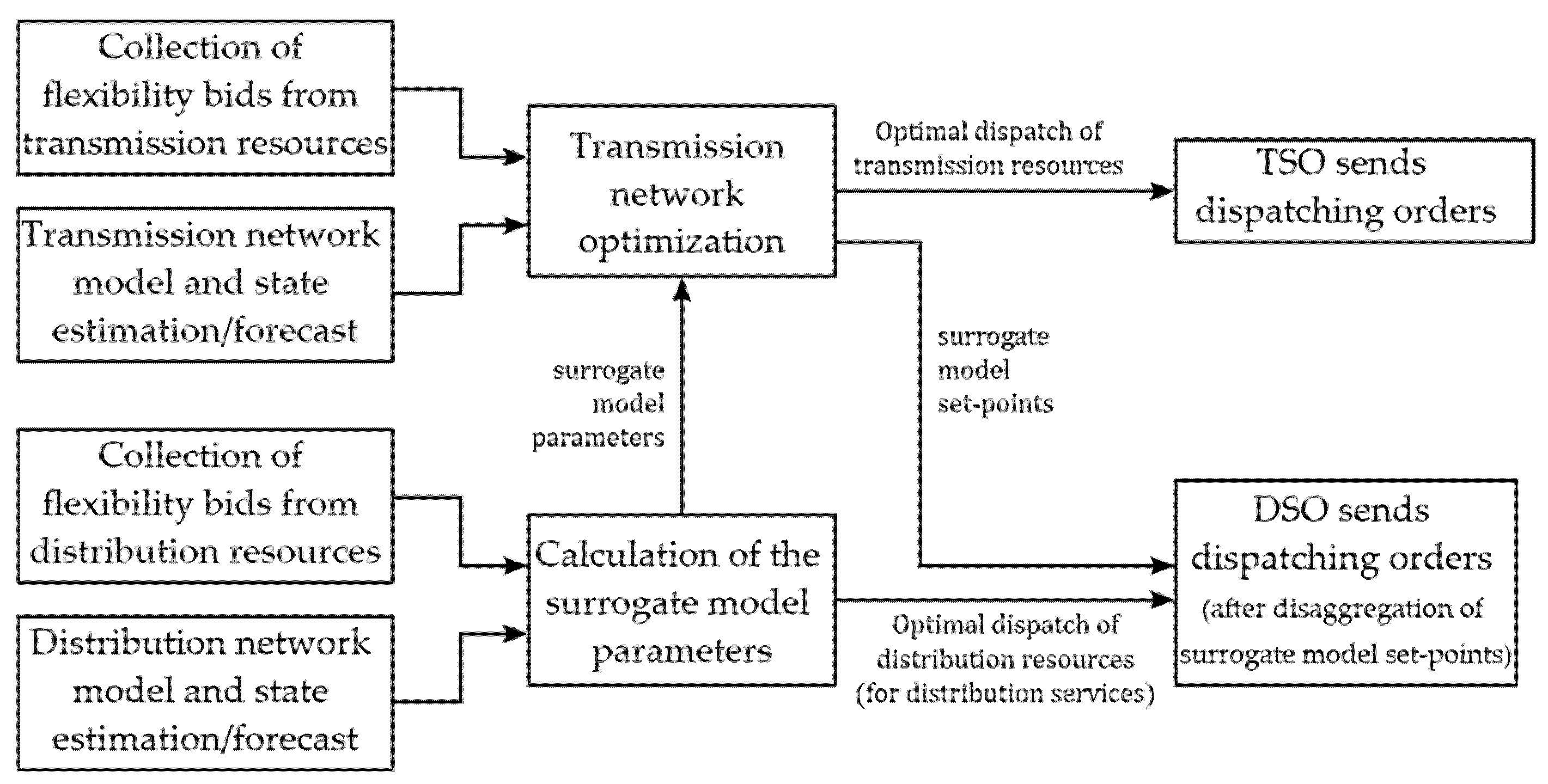

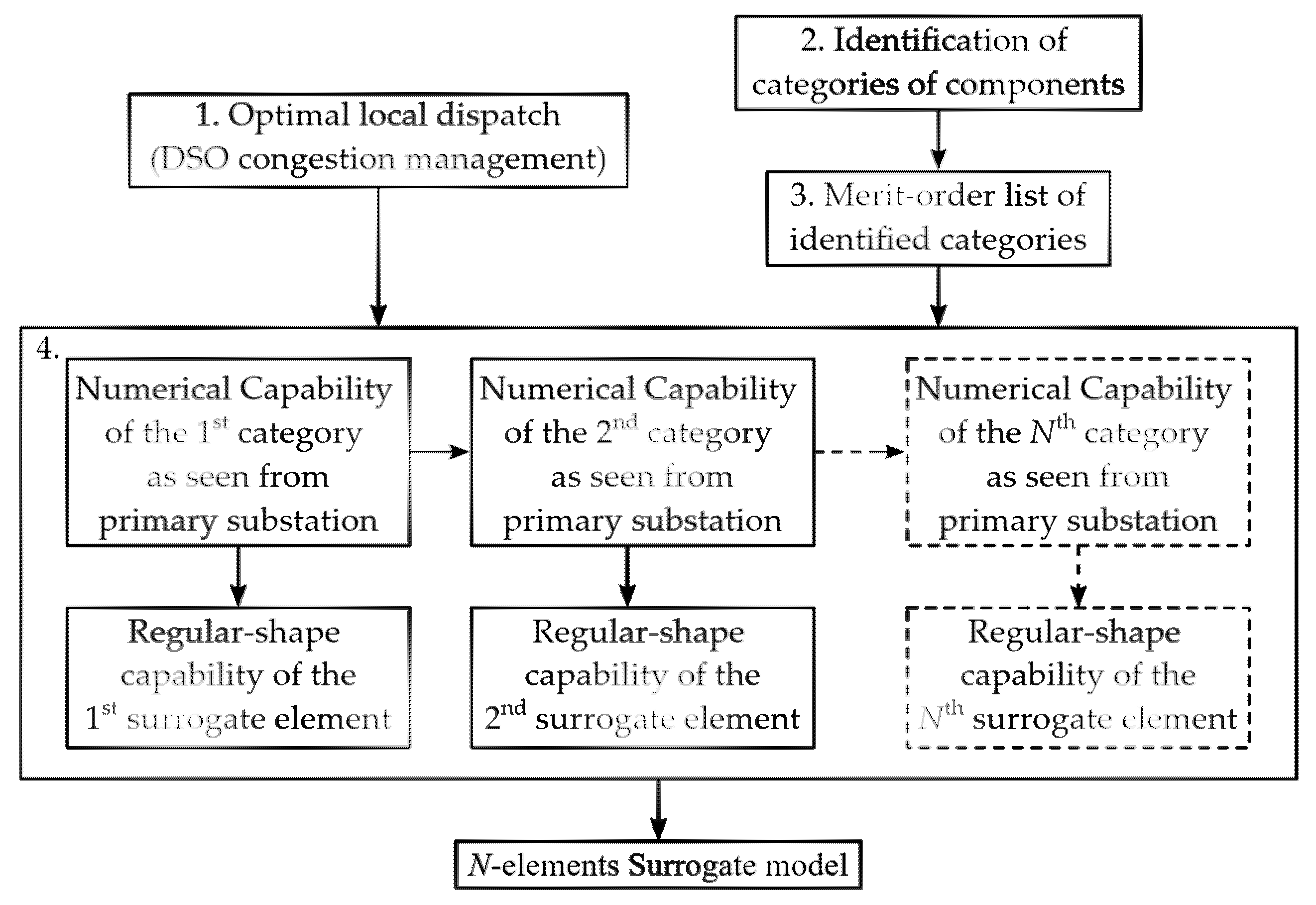
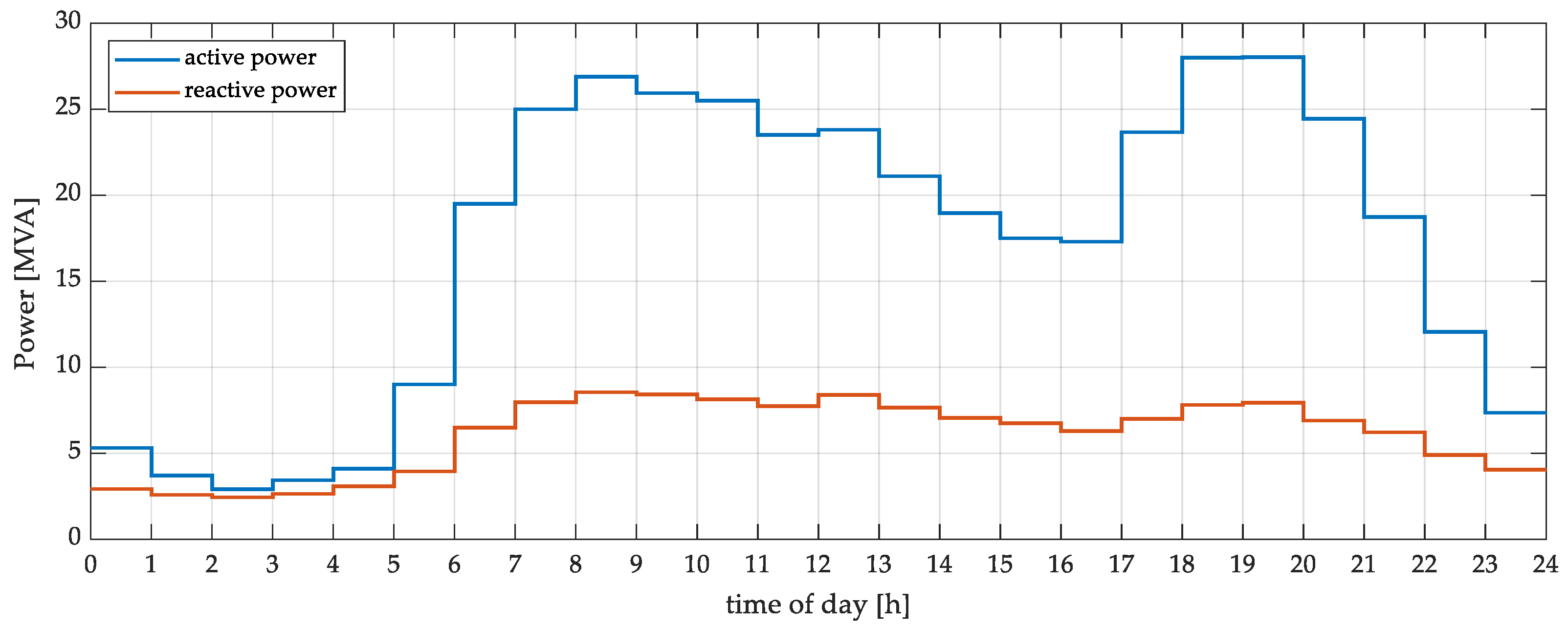


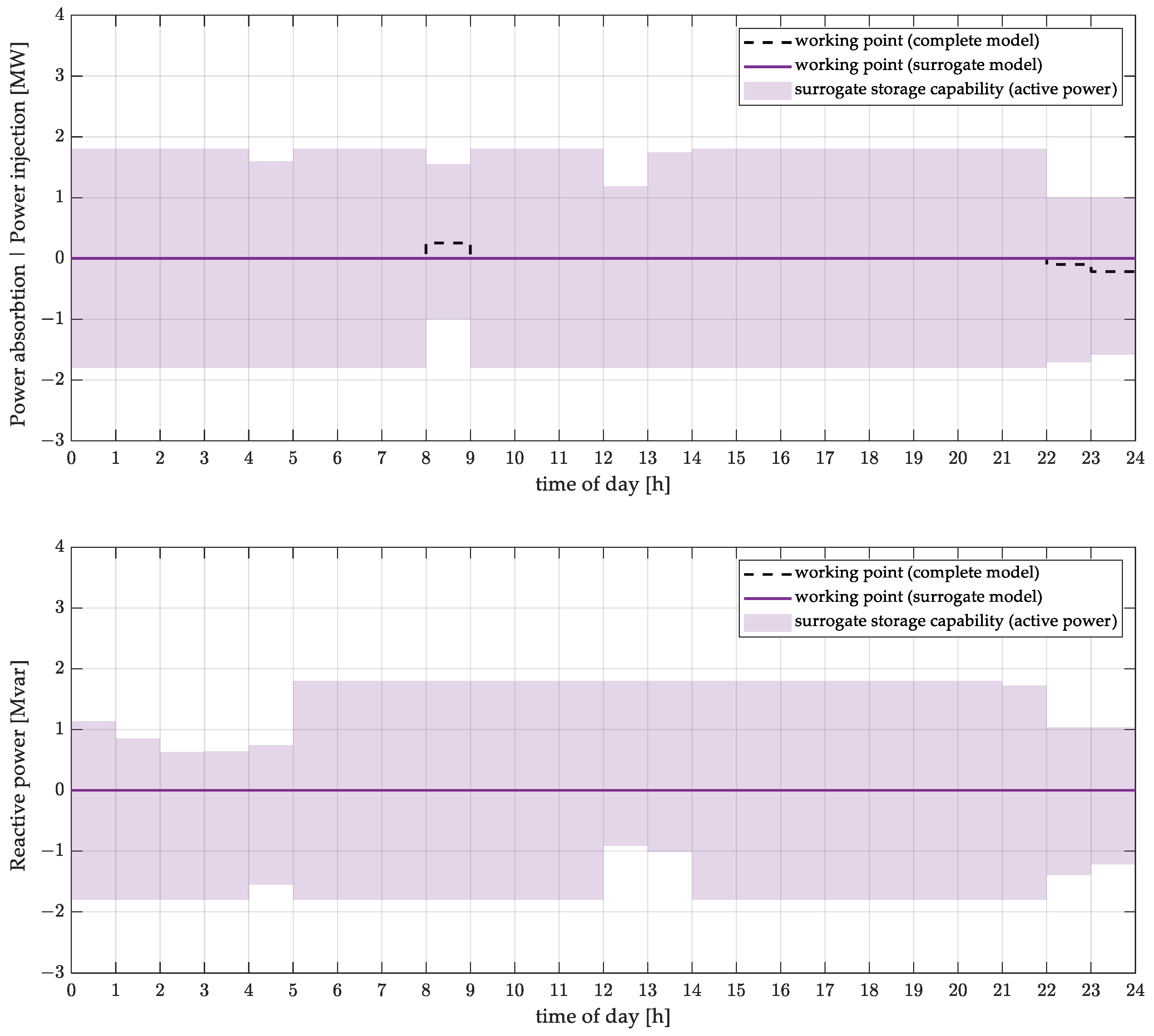
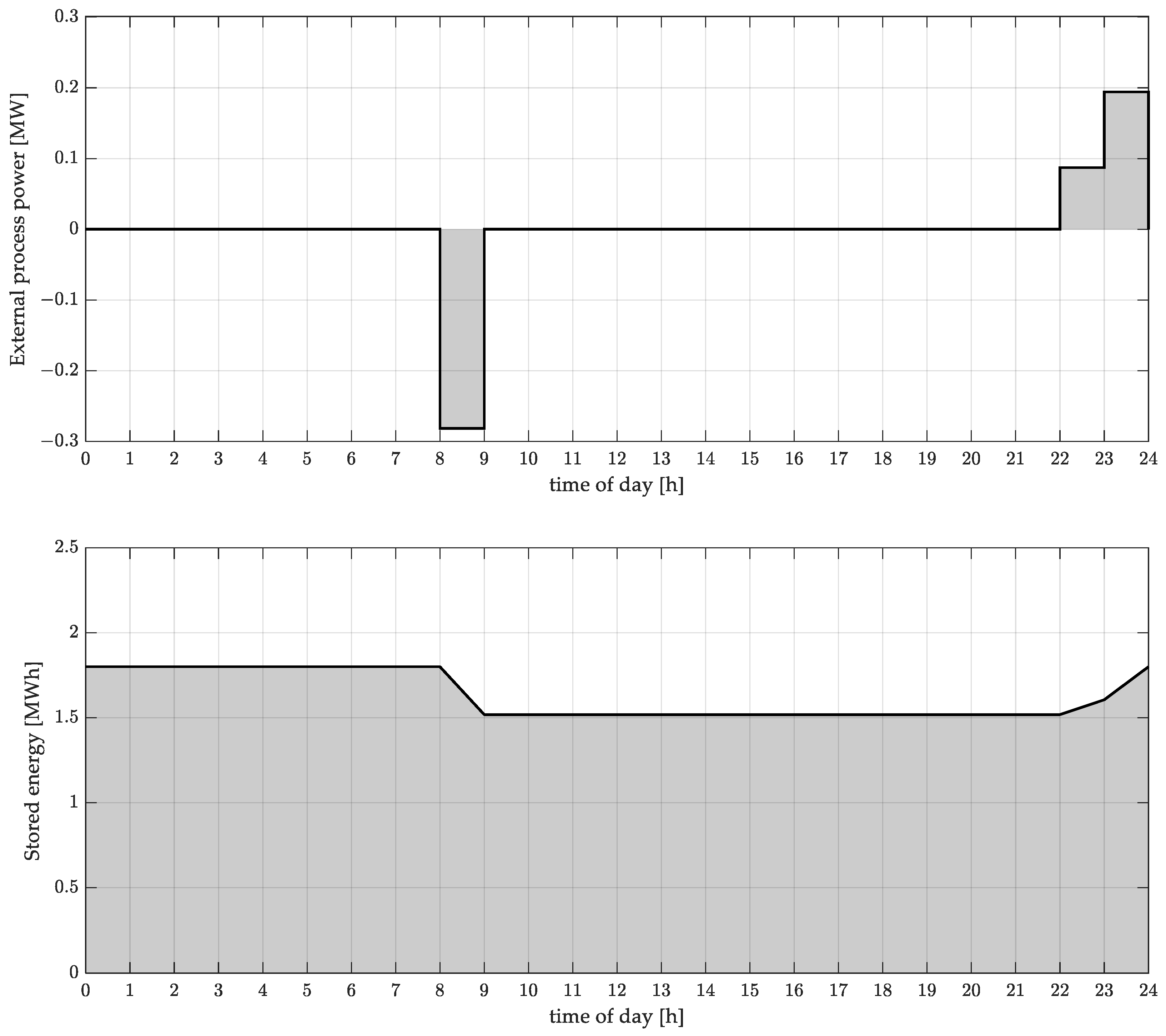
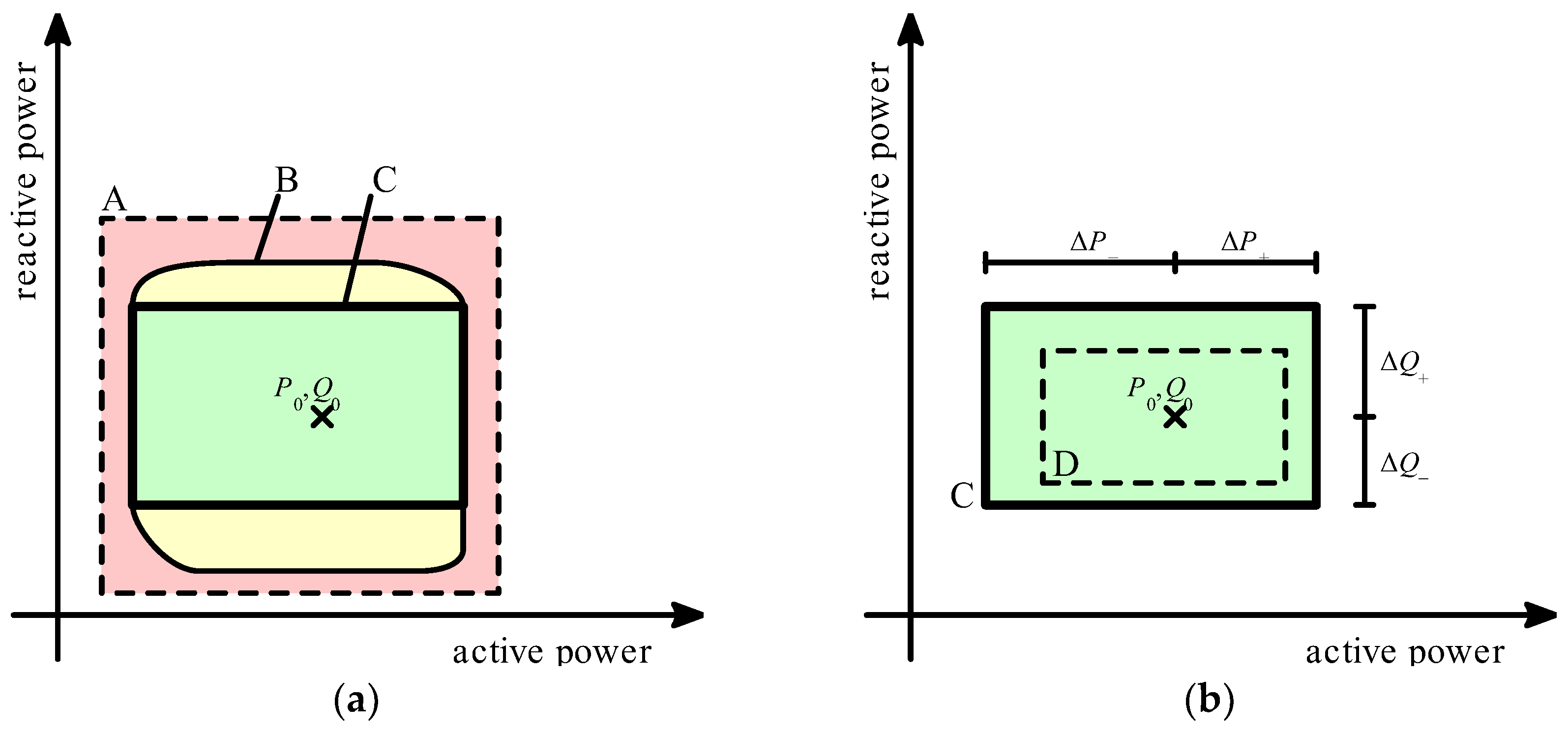

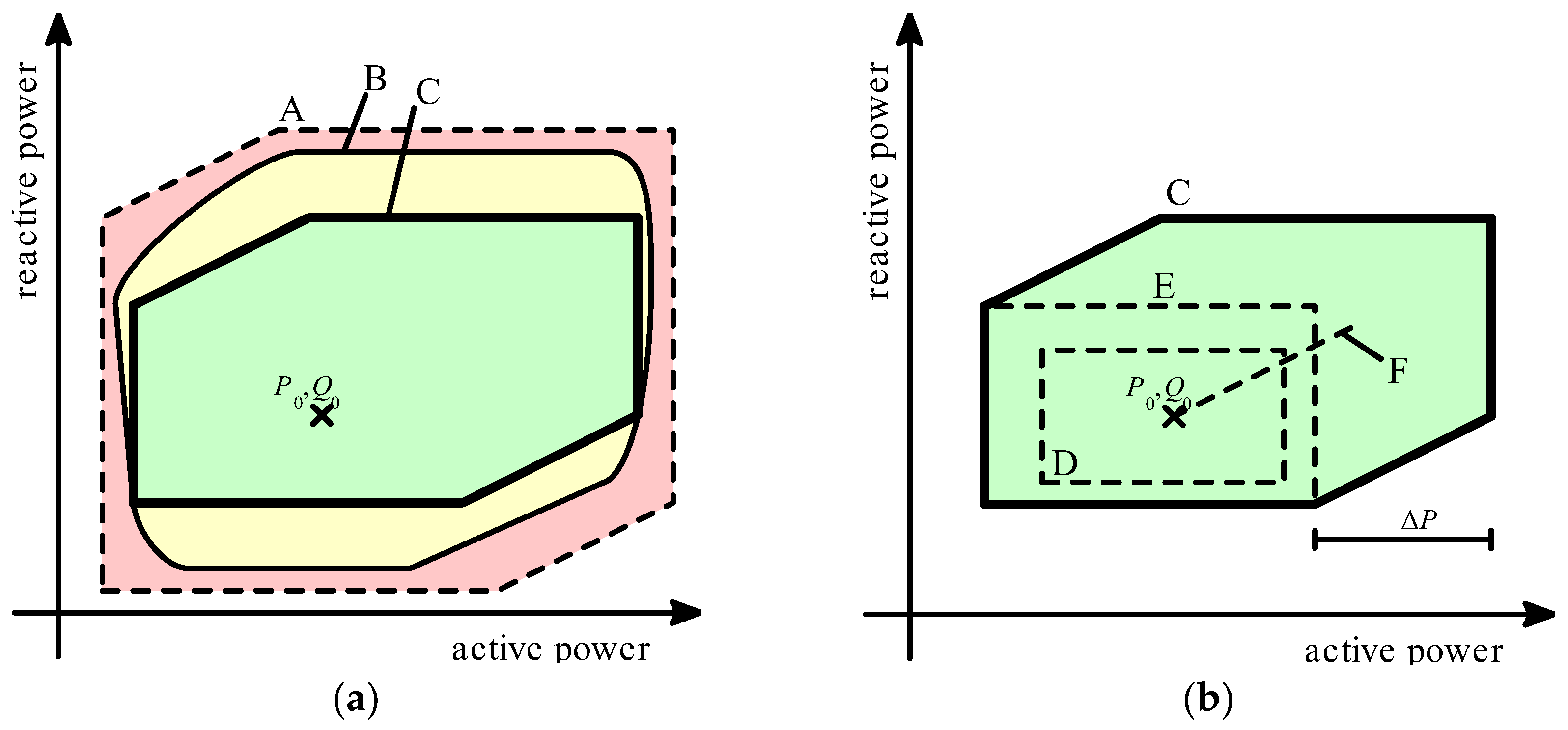
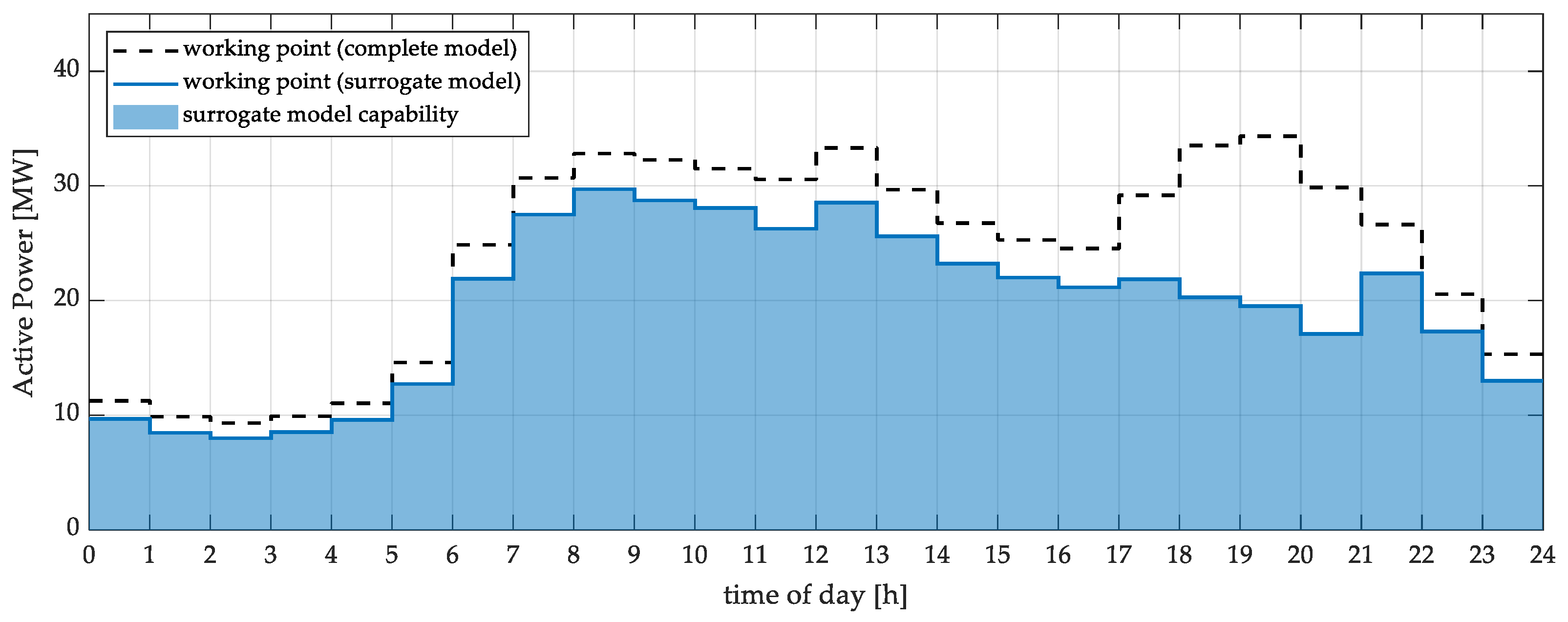
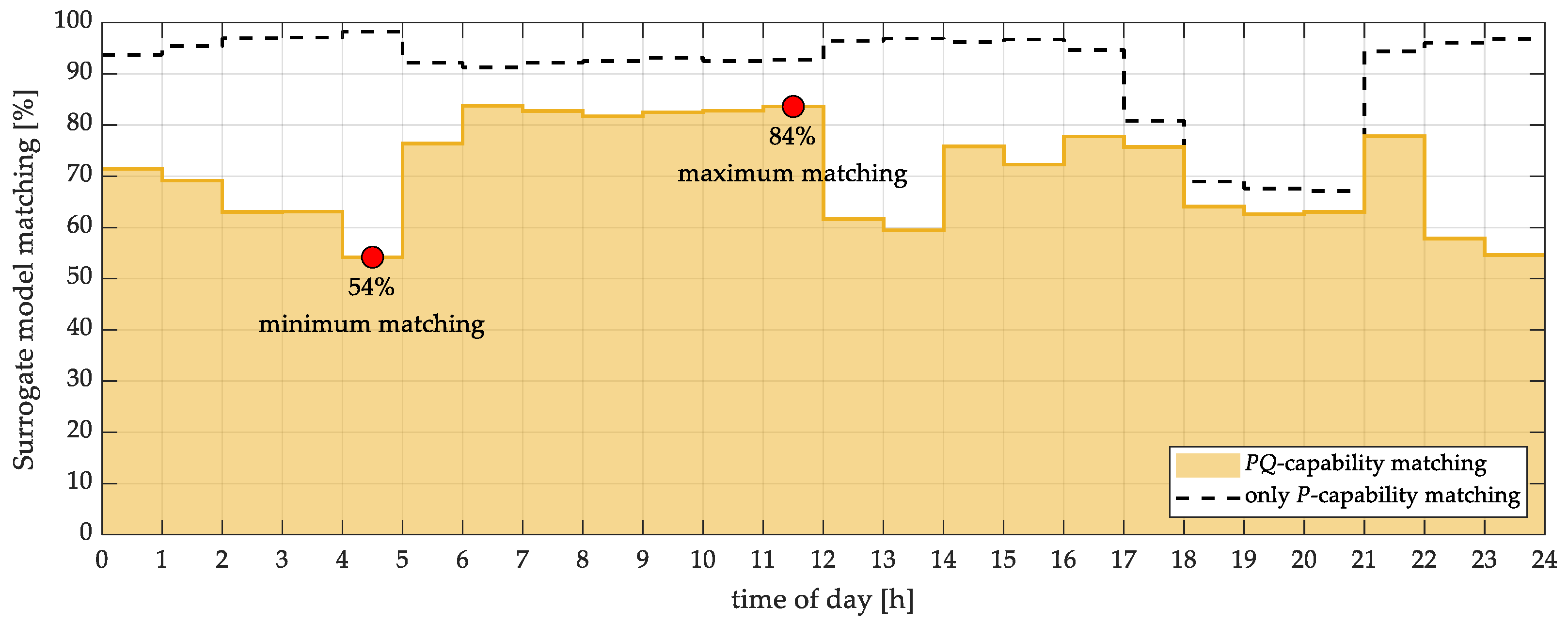

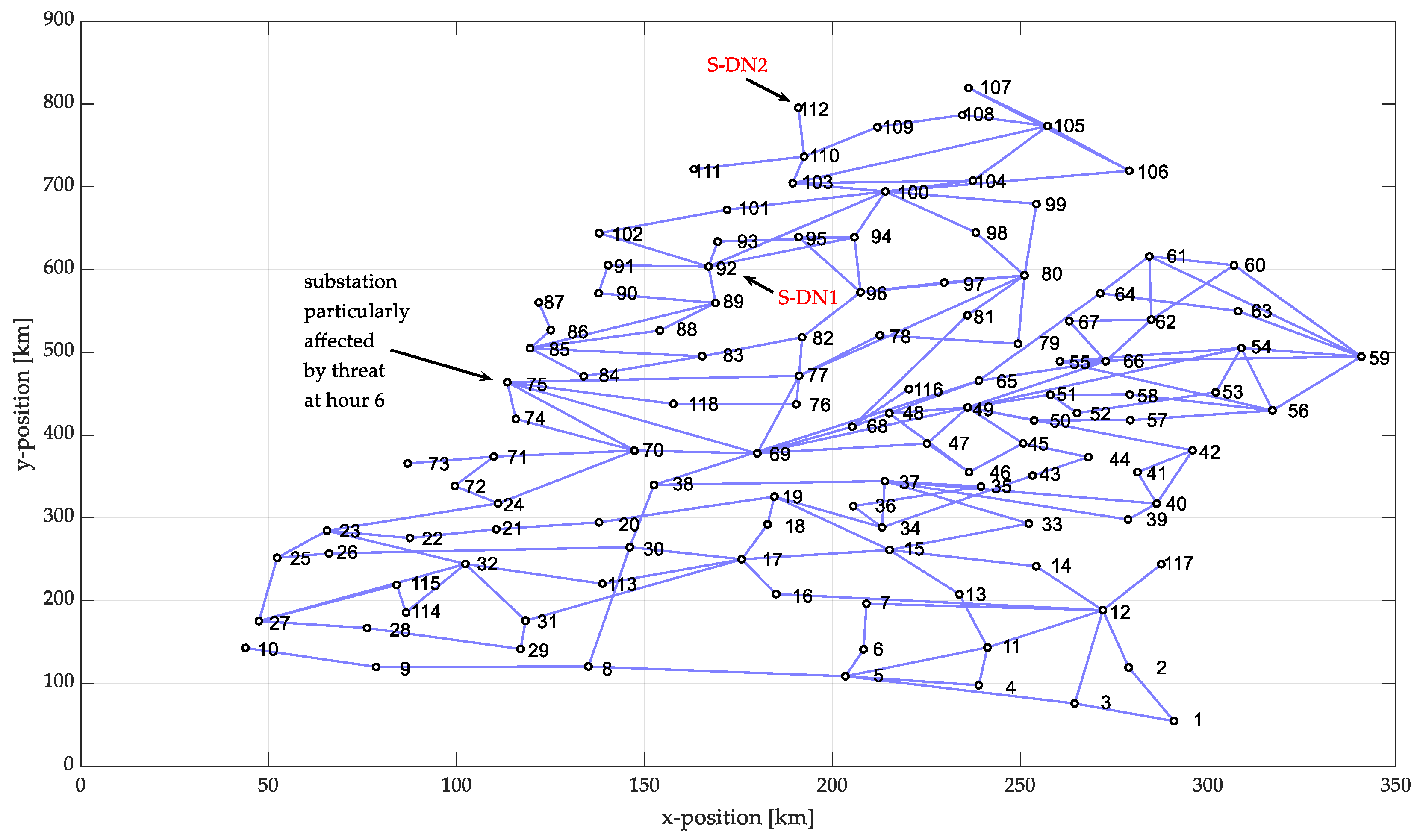
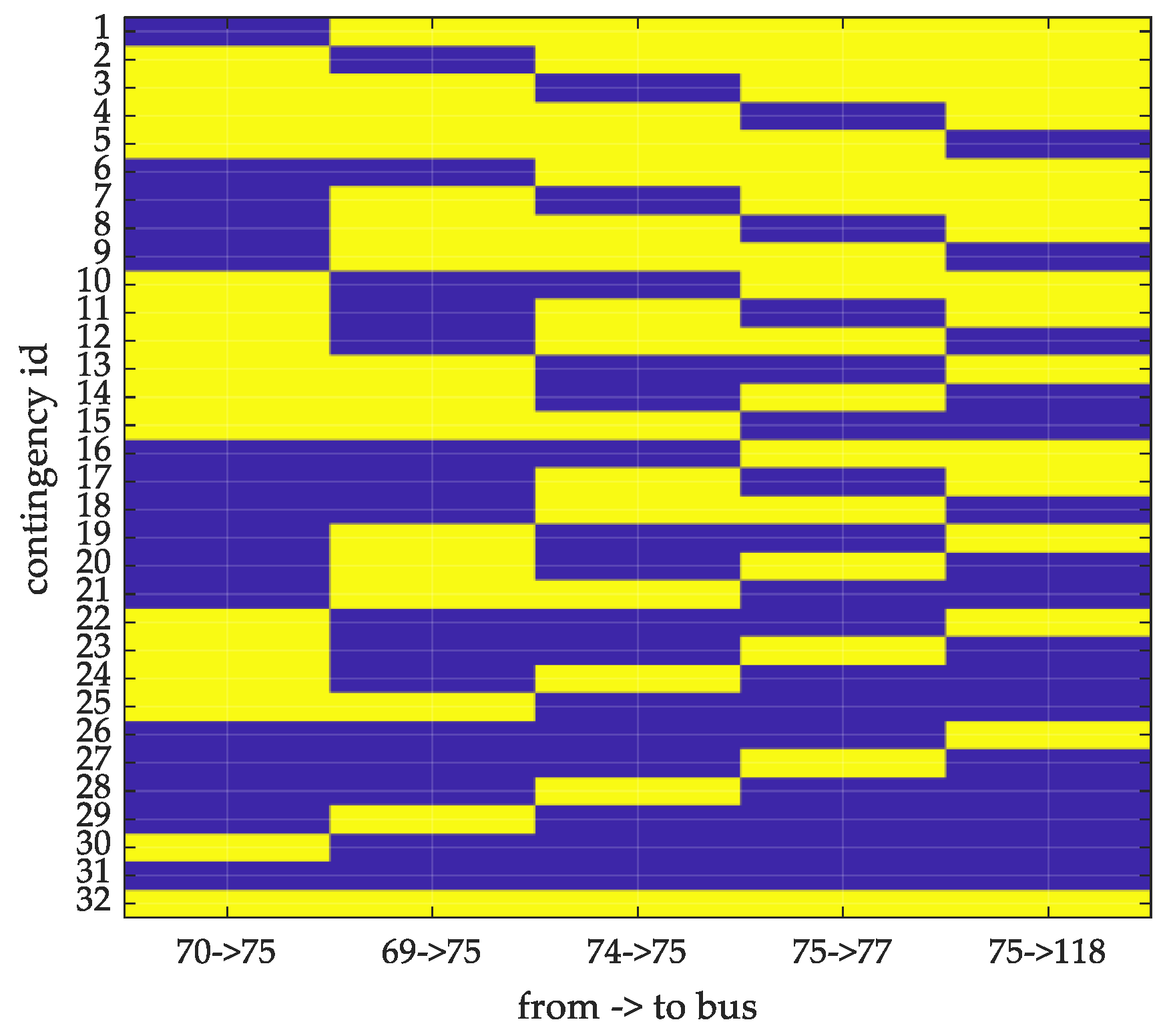
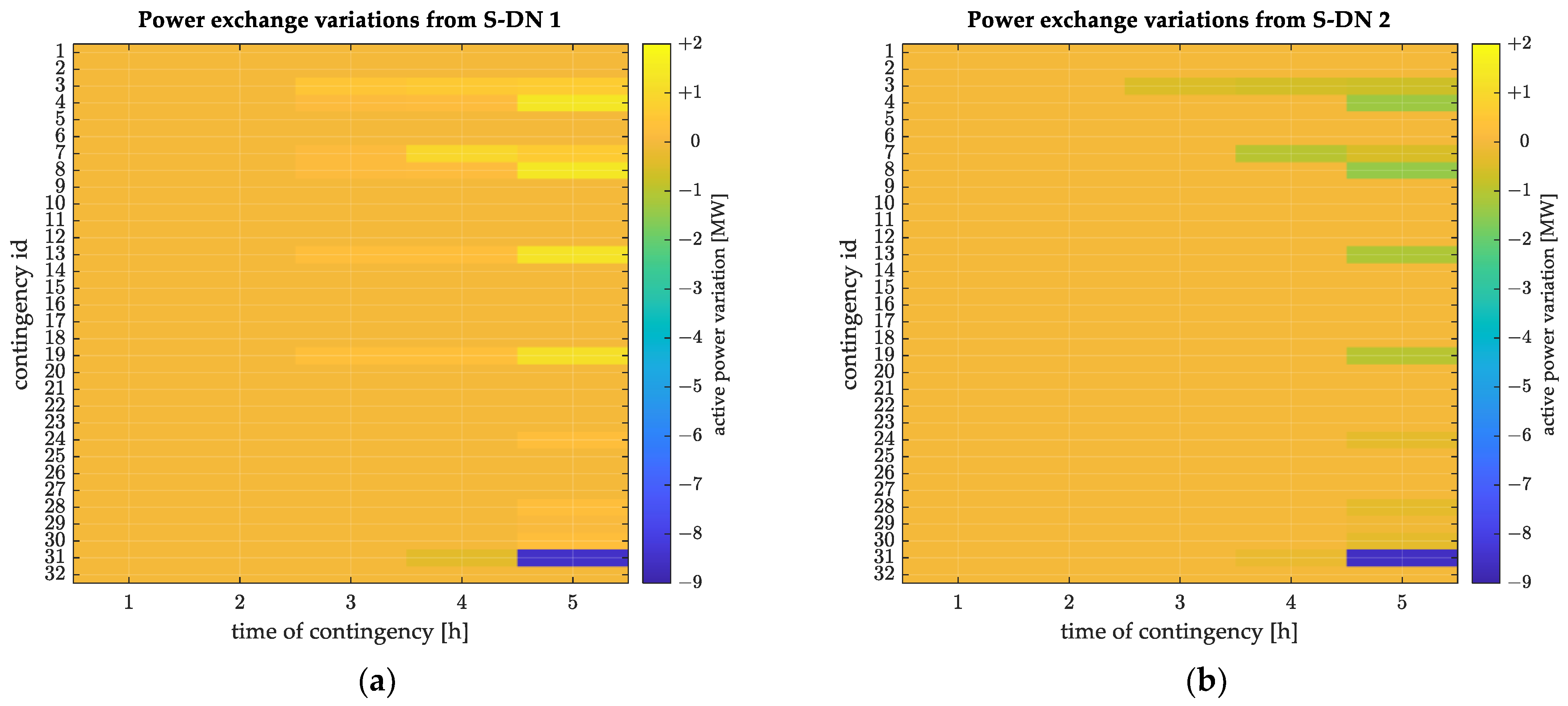
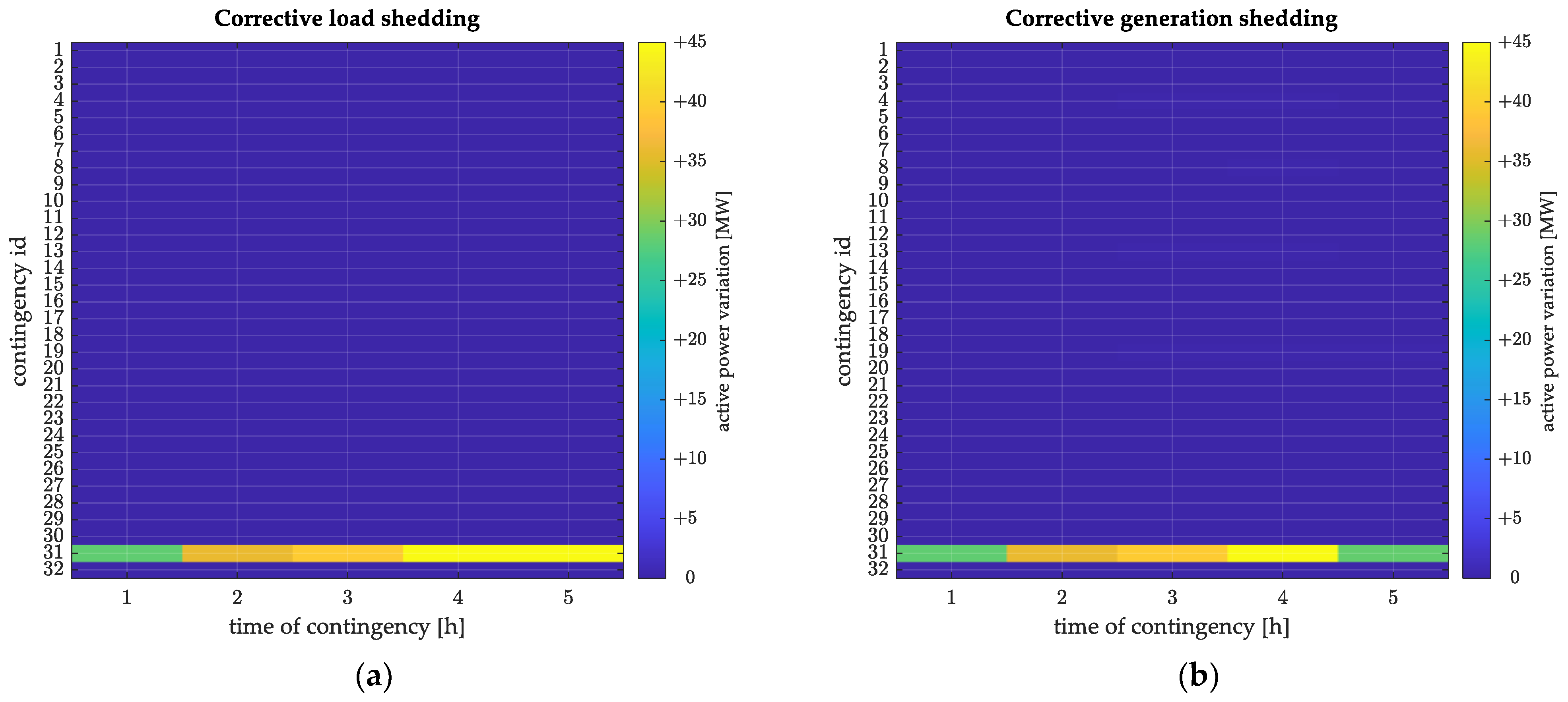
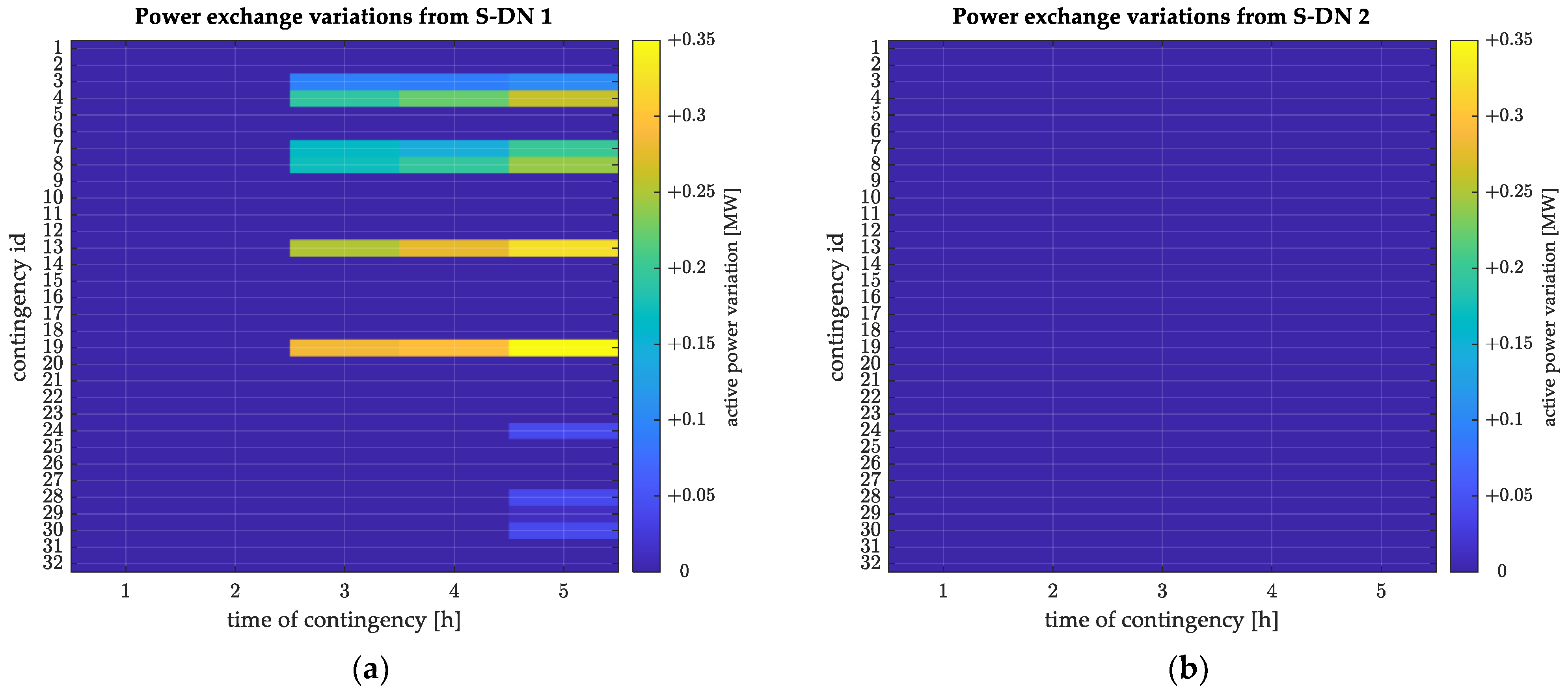
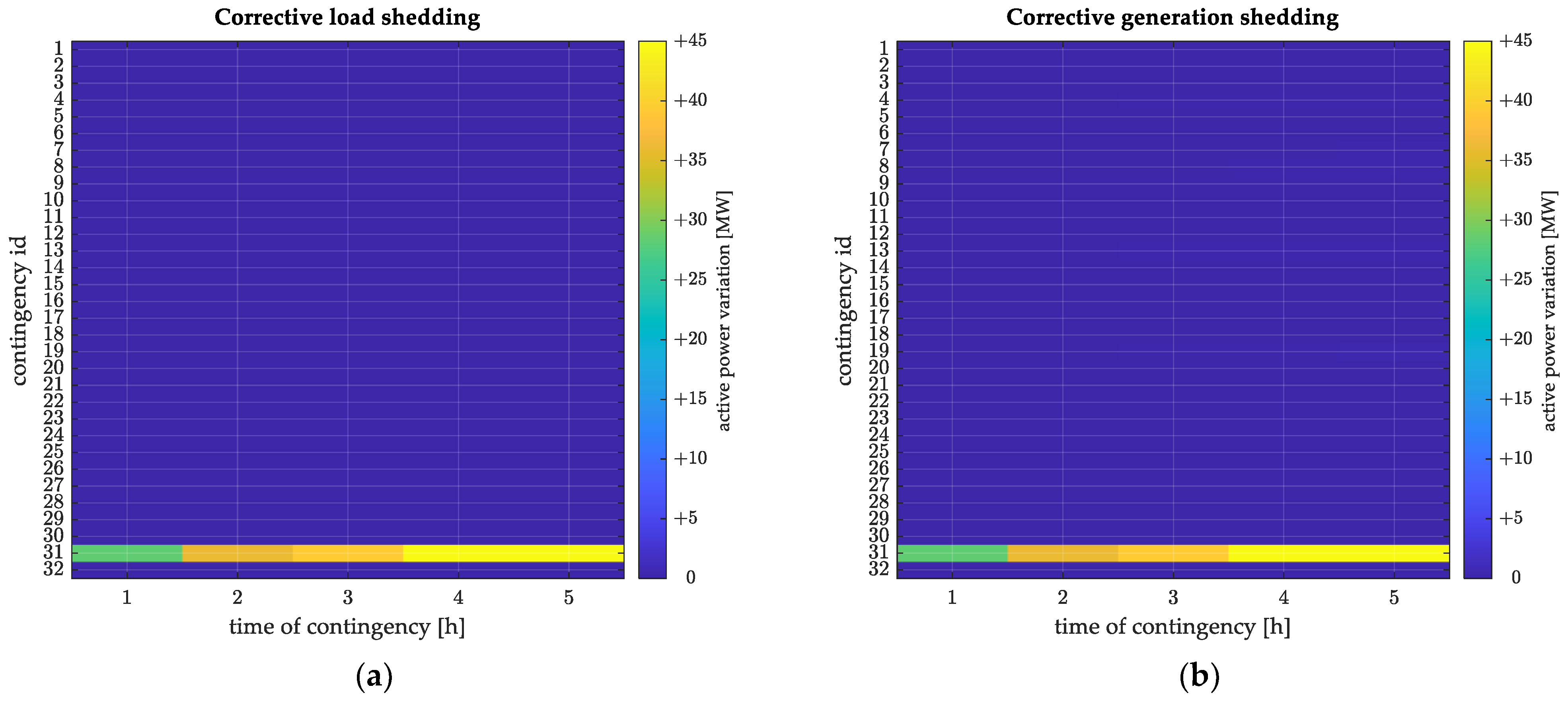


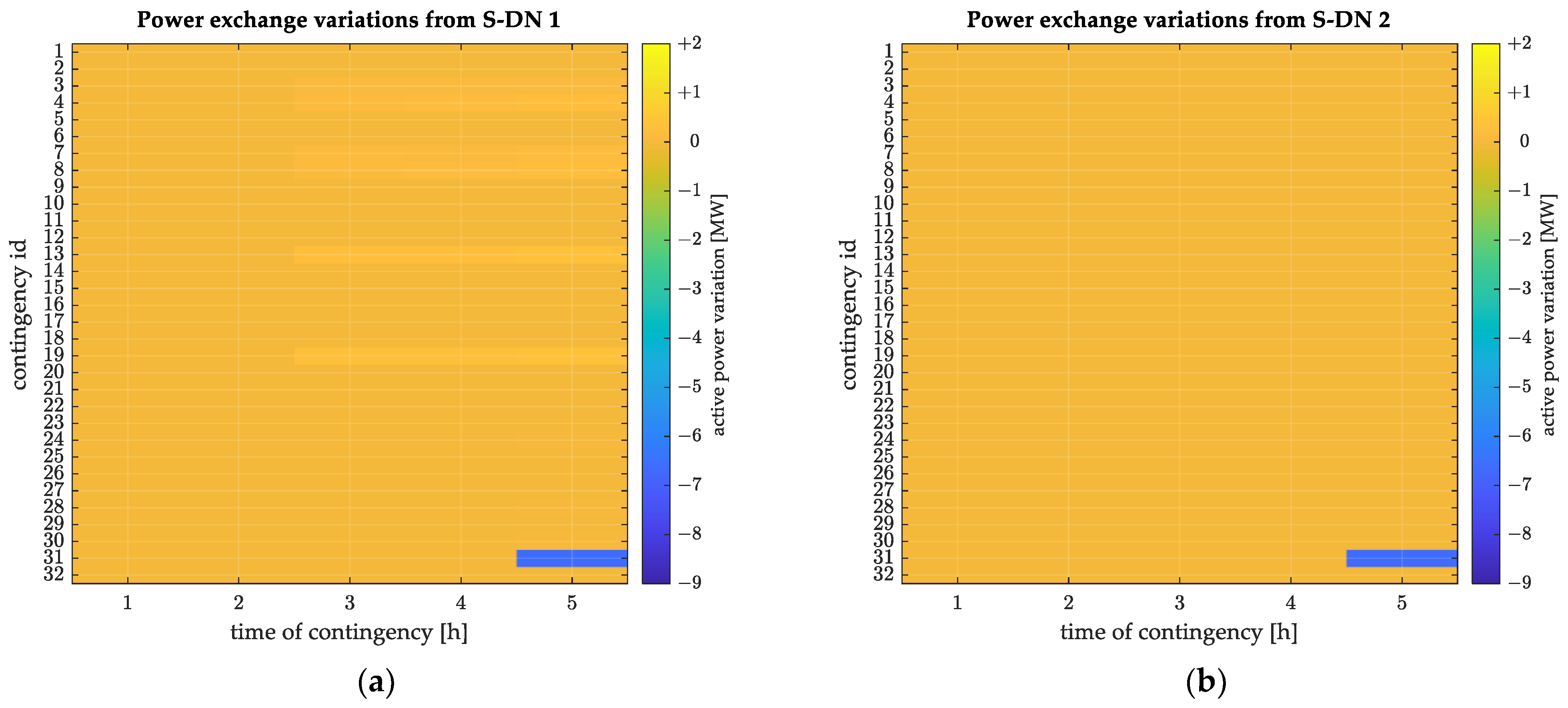
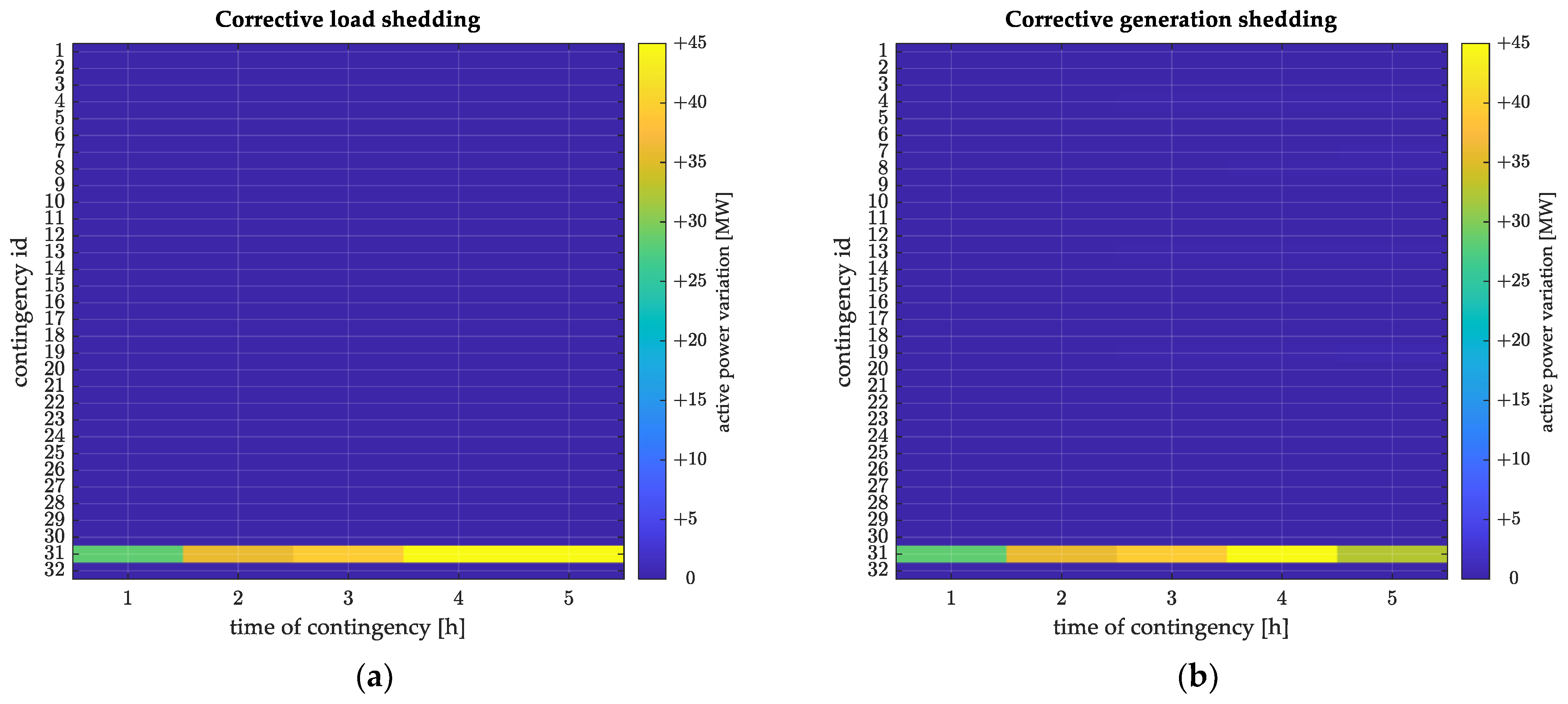
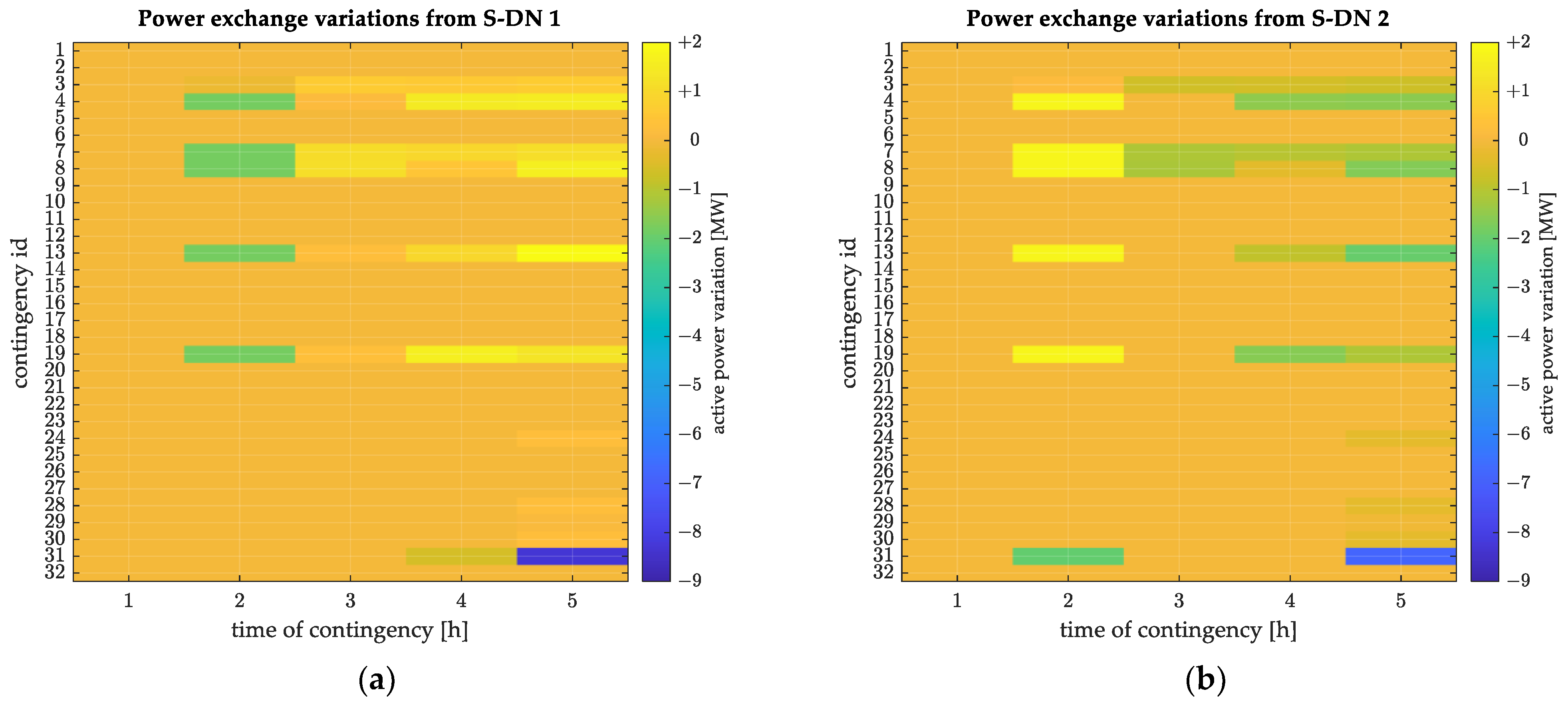

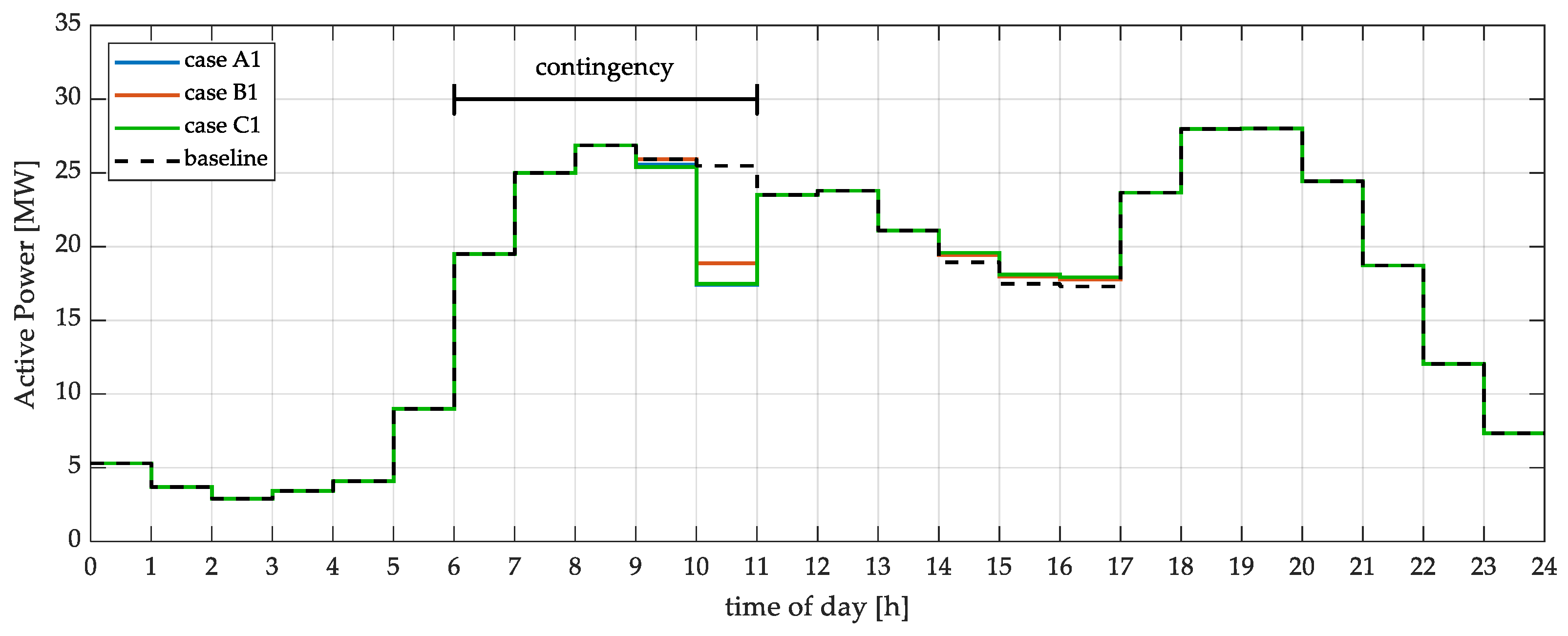
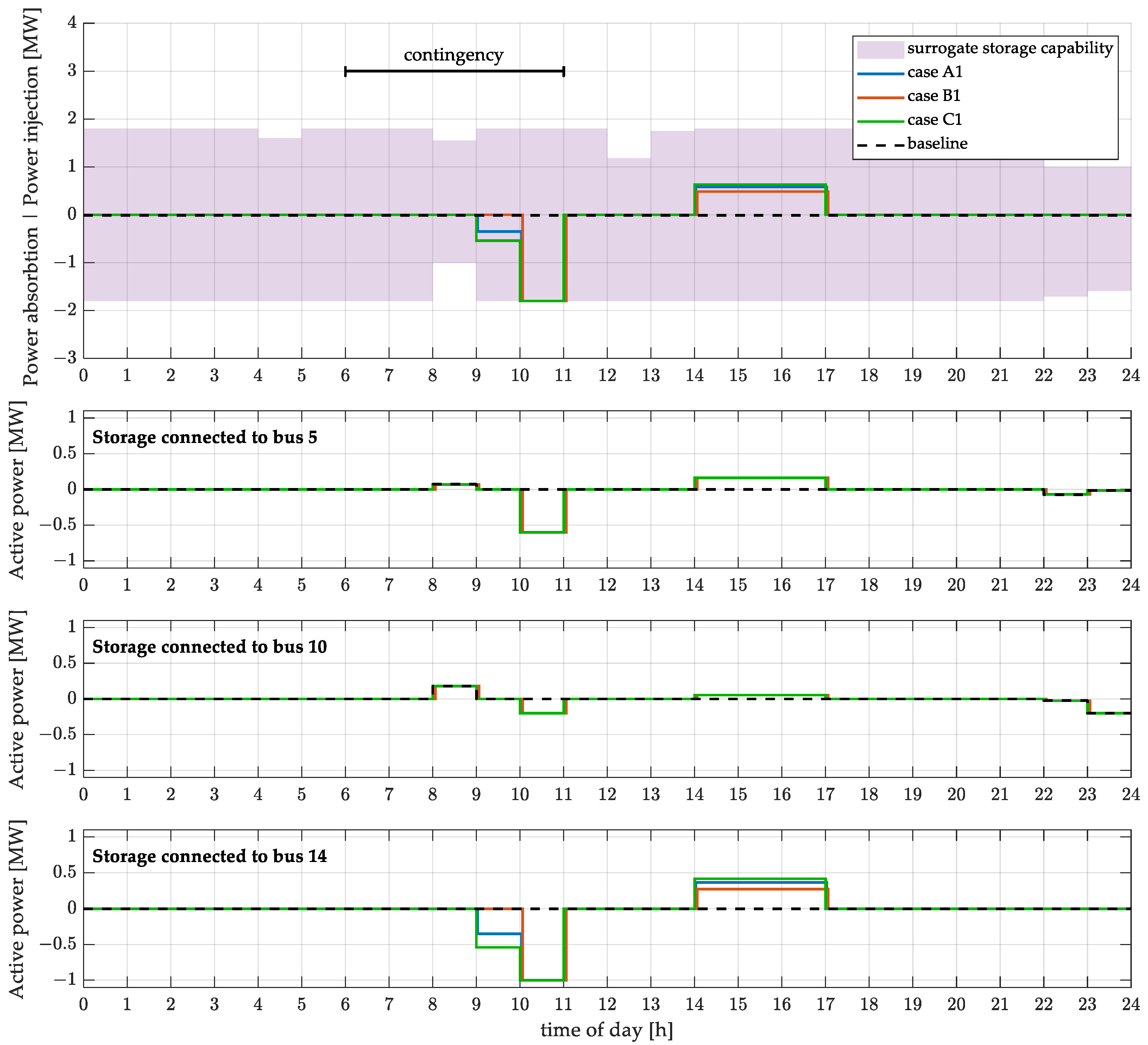
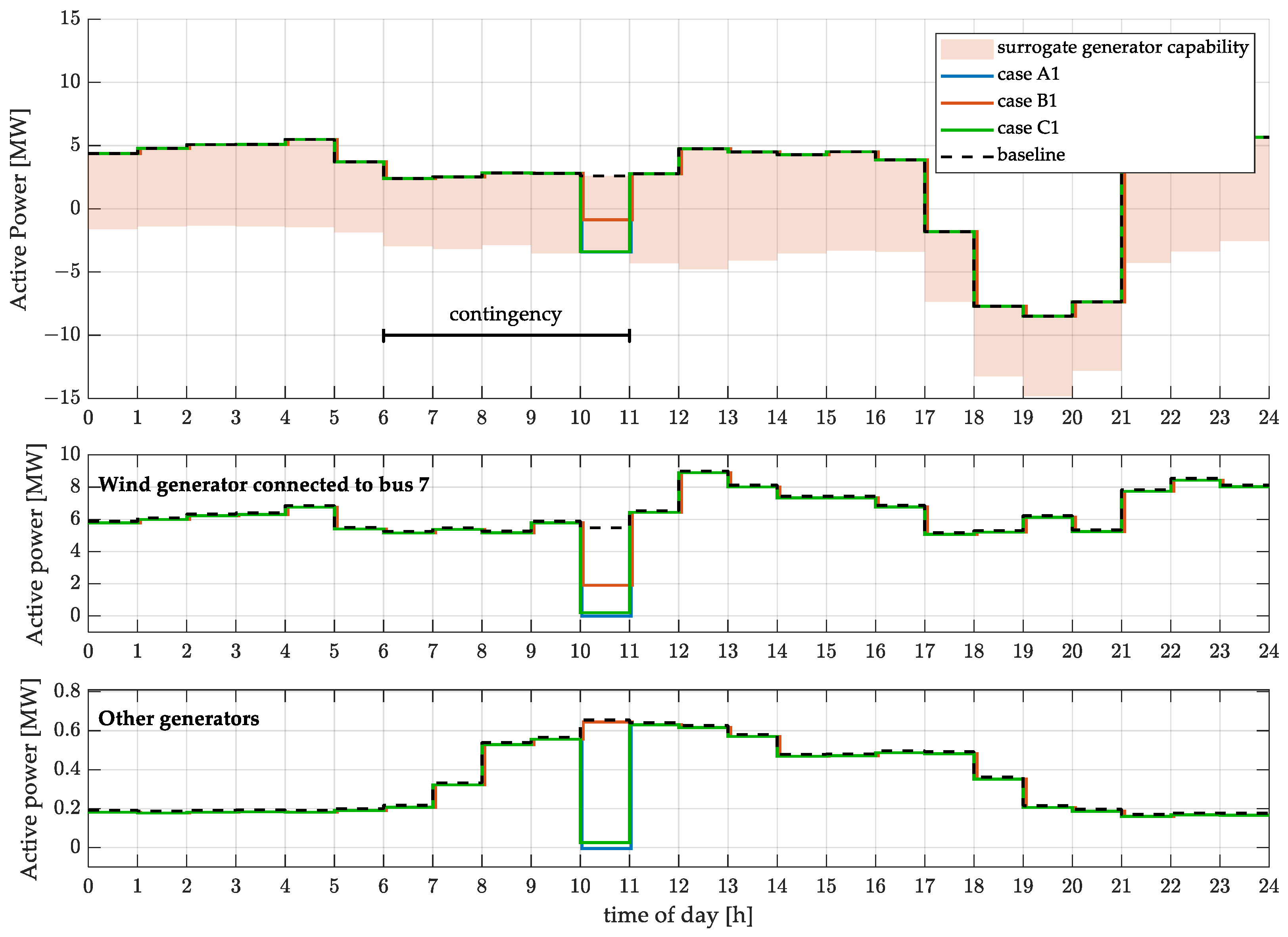
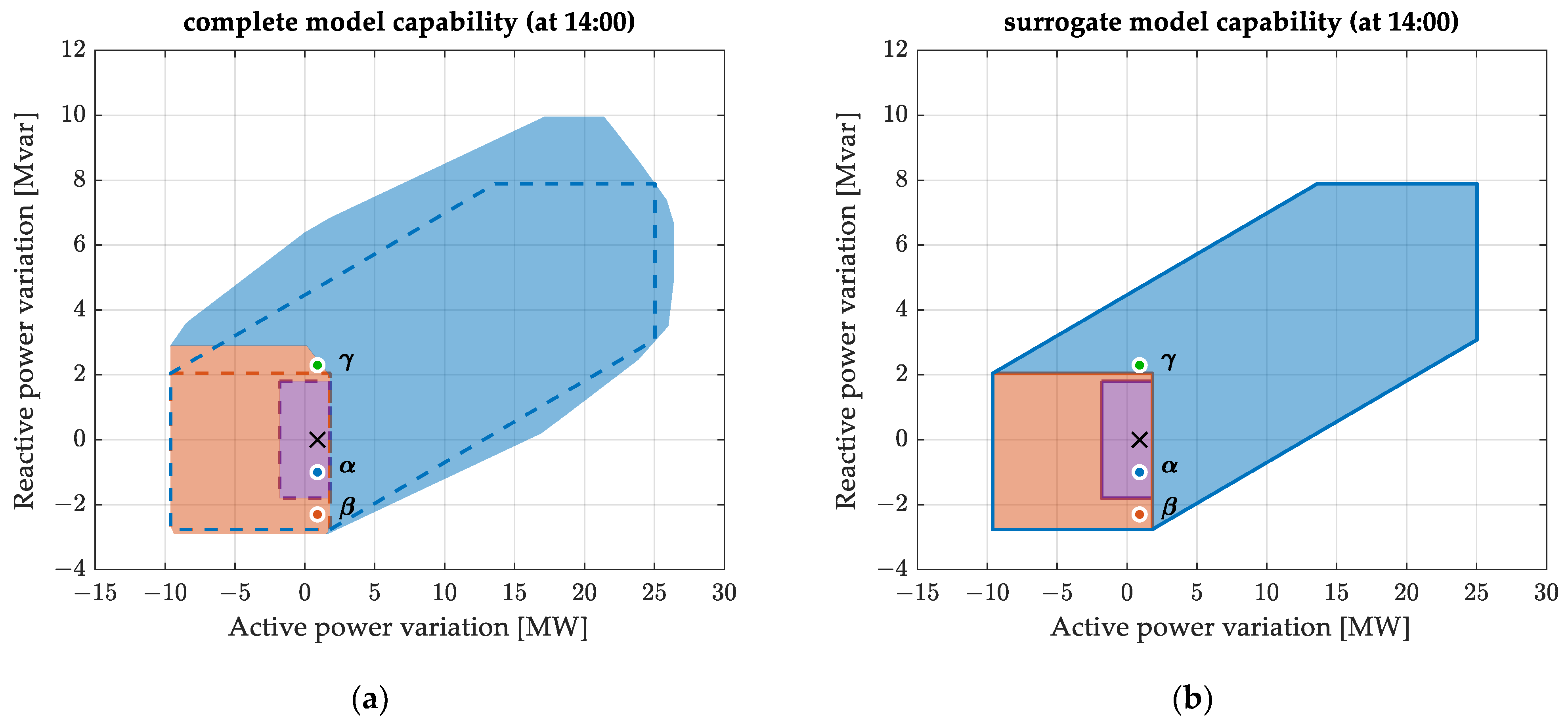
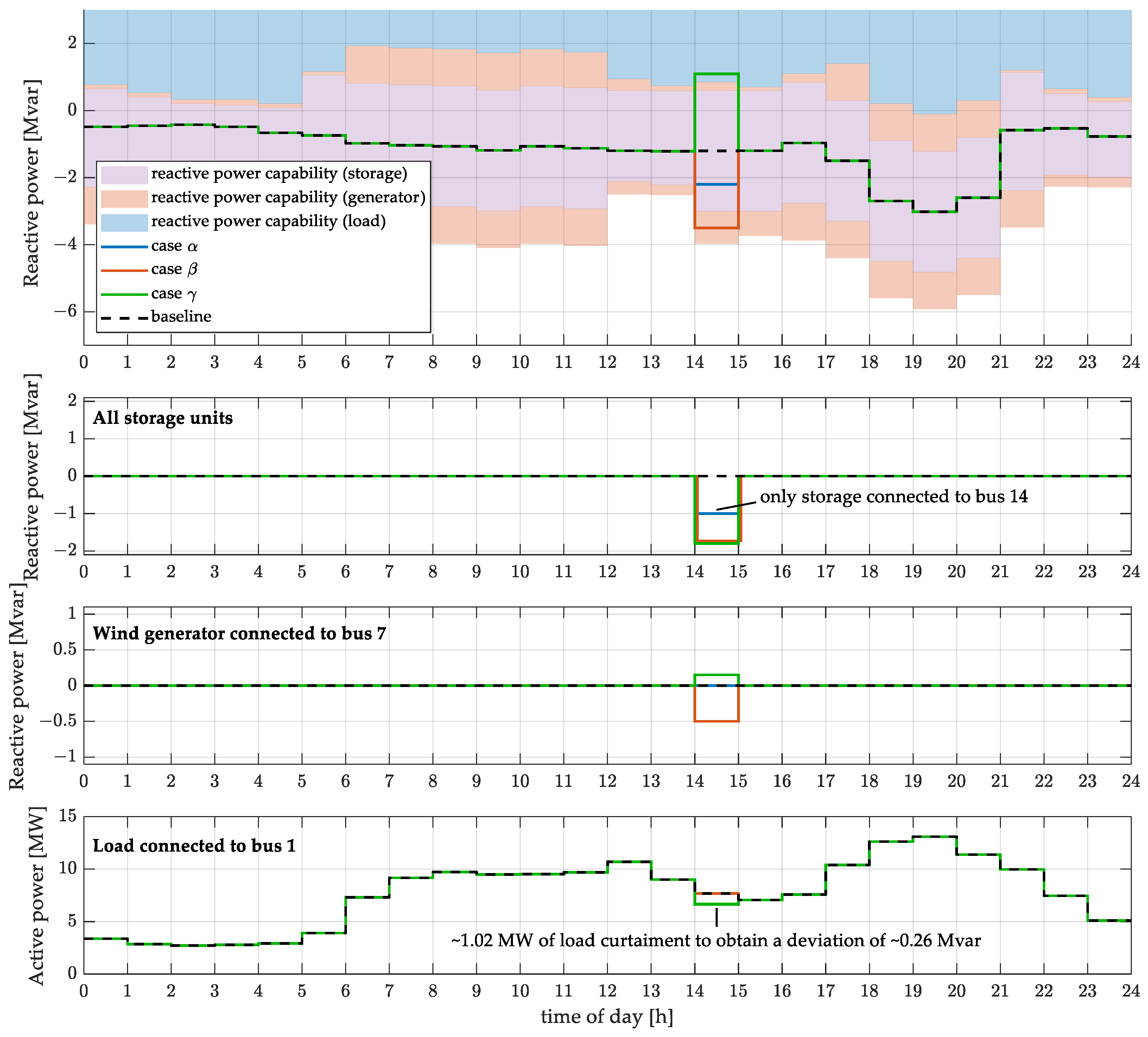
| Quantity | Costs [amu/MWh] | ||
|---|---|---|---|
| Profile A | Profile B | Profile C | |
| unitary cost for charge of surrogate storage | −20 | −50 | −5 |
| unitary cost for discharge of surrogate storage | 100 | 400 | 20 |
| unitary cost for upward variation of surrogate generator | 150 | 400 | 20 |
| unitary cost for downward variation of surrogate generator | −20 | −50 | −5 |
| unitary cost for curtailment of surrogate load | 25,000 | 25,000 | 25,000 |
| unitary cost for load shedding (no ancillary services) | 40,000 | 40,000 | 40,000 |
| unitary cost for generation shedding (no ancillary services) | 500 | 500 | 500 |
| Case ID | Operating Behavior | Cost Profile |
|---|---|---|
| A1 | 1 | A |
| A2 | 2 | - |
| A3 | 3 | - |
| B1 | 1 | B |
| C1 | 1 | C |
Disclaimer/Publisher’s Note: The statements, opinions and data contained in all publications are solely those of the individual author(s) and contributor(s) and not of MDPI and/or the editor(s). MDPI and/or the editor(s) disclaim responsibility for any injury to people or property resulting from any ideas, methods, instructions or products referred to in the content. |
© 2025 by the authors. Licensee MDPI, Basel, Switzerland. This article is an open access article distributed under the terms and conditions of the Creative Commons Attribution (CC BY) license (https://creativecommons.org/licenses/by/4.0/).
Share and Cite
Rossi, M.; Pitto, A.; Ciapessoni, E.; Viganò, G. A Surrogate Modeling Approach for Aggregated Flexibility Envelopes in Transmission–Distribution Coordination: A Case Study on Resilience. Energies 2025, 18, 5567. https://doi.org/10.3390/en18215567
Rossi M, Pitto A, Ciapessoni E, Viganò G. A Surrogate Modeling Approach for Aggregated Flexibility Envelopes in Transmission–Distribution Coordination: A Case Study on Resilience. Energies. 2025; 18(21):5567. https://doi.org/10.3390/en18215567
Chicago/Turabian StyleRossi, Marco, Andrea Pitto, Emanuele Ciapessoni, and Giacomo Viganò. 2025. "A Surrogate Modeling Approach for Aggregated Flexibility Envelopes in Transmission–Distribution Coordination: A Case Study on Resilience" Energies 18, no. 21: 5567. https://doi.org/10.3390/en18215567
APA StyleRossi, M., Pitto, A., Ciapessoni, E., & Viganò, G. (2025). A Surrogate Modeling Approach for Aggregated Flexibility Envelopes in Transmission–Distribution Coordination: A Case Study on Resilience. Energies, 18(21), 5567. https://doi.org/10.3390/en18215567







